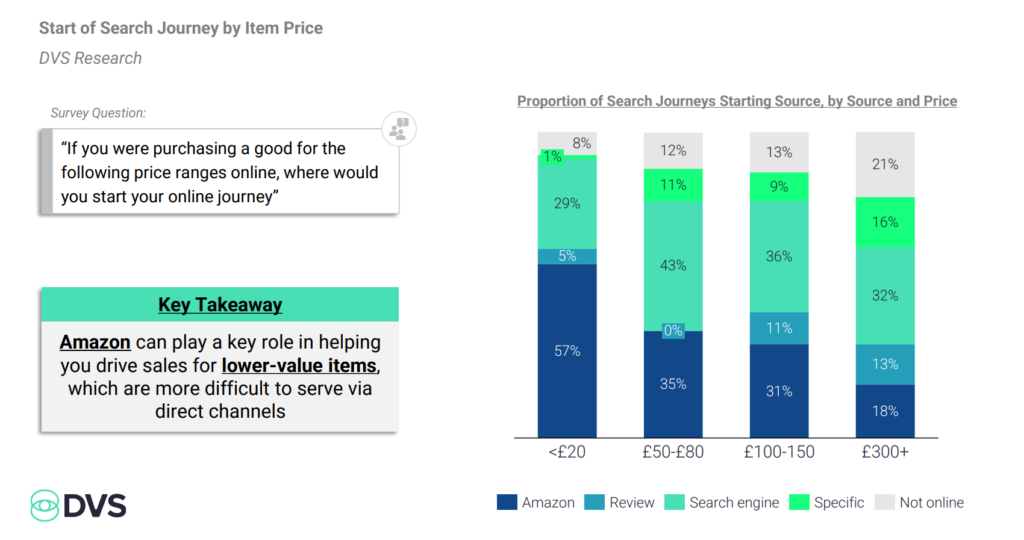Over the last twenty years, Amazon has grown from a small player in the retail space, to a formidable selling platform. For many retail companies with their own shop fronts and online stores, building a successful strategy around engagement with Amazon is and should be a crucial part of the business model.
We at DVS wanted to understand the interaction between channels and how much of Amazon sales can be incremental for retailers.
Amazon as the first port of call
Amazon has become its own source of traffic, with roughly 60% of Amazon shoppers going directly to Amazon to begin their product search. Both external reports and our own research suggest that that more than 50% of total product searches in the UK start on Amazon.

Interestingly, consumers behaviours differ depending on the price point of the product:
- Where almost 60% of product searches for items below £20 start on Amazon, this drops to between 30-40% for more expensive items.
- One potential interpretation of this is that where the purchase is for an item that is needed more urgently, and is a less considered purchase, consumers will focus on ease of their shopping experience and go directly to Amazon.
- Where purchases are more significant to the consumer, this is decreasingly the case.
So what does this mean for retail companies? It means that there is a significant demand market for cheaper items that is only accessible by listing on Amazon. There is value in choosing to sell through their platform, and doing so in a strategic manner can be hugely beneficial.
The interaction between Amazon and direct
Having worked with a client recently to understand their consumers’ shopping habits, we saw clear evidence of omni-channel customers. These tended to fall into two main camps:
- Shoppers who use Amazon for low-value items, and direct for higher-value items
- Shoppers who are more ambivalent in the value of the items they purchase from each channel, with urgency of delivery potentially directing their decisions
Not only this, we saw clear evidence that Amazon acted as a channel for new customer acquisition, with customers making their first purchase on Amazon, and then proceeding to shop direct thereafter. This can be utilised by retail companies by building a branding and marketing strategy that encourages Amazon consumers to proceed to purchase direct. By prioritising different facets of this strategy for low-value and high-value items, businesses can capitalise on the opportunity available here.
Key Strategic Implications
So, it is clear that Amazon is not only a potentially valuable opportunity for retail businesses, but that a strong strategy around this is key. There are many different ways to streamline and improve how businesses interact with the platform. Some of these include:
- range prioritisation
- marketing
- seller hygiene
- shop-front management
- branding
- balancing the use cases of FBA and FBM product sales
If you’re interested in exploring these possibilities further, and understanding how you can win in the Amazon space, get in touch with us today at contact@datavisionservices.co.uk.

Sweeping US Tariffs: What This Means for the UK